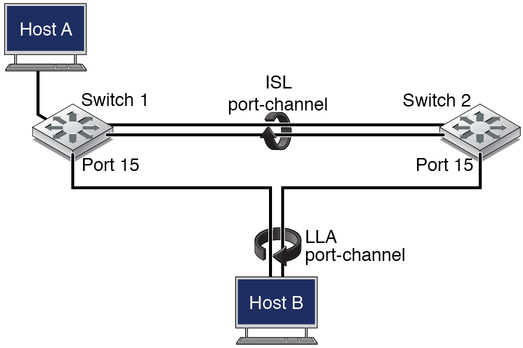| Skip Navigation Links | |
| Exit Print View | |

|
Sun Ethernet Fabric Operating System LLA Administration Guide |
To configure LLA on a switch, you must first configure the LLA and ISL port-channels.
Connect the host to one port on each of the switches. The connections must be to the same port number on both switches. Form an aggregate on the host with the interfaces connected to these ports. Both active-active and active-standby configurations for aggregate ports are allowed.
On each switch, create the LLA port-channel, ISL port-channel and add the member ports. The LLA port on each switch is the port connected to the host. The ISL ports are the ports connecting the two switches. The LLA port-channel and corresponding member ports must be the same on both switches. Then configure the LLA role as primary or secondary for both switches. Ensure that one switch is the primary and the other the secondary. Then enable LLA. If the enable LLA command is not executed, LLA will not be enabled after restart, even though the LLA role and ports are configured. Then restart the SEFOS on the switches. After the restart, LLA will be operable and the switches will assume their respective roles.
Switch-<n>(config)# interface port-channel 101 The LLA port-channels are reserved from 101 to 124. The mode changes to port-channel configuration. Switch-<n>(config-if)# no shut Switch-<n>(config-if)# exit
Switch-<n>(config)# interface port-channel 100 The port-channel 100 is reserved for ISL. The mode changes to port-channel configuration. Switch-<n>(config-if)# spanning-tree cost 10 The ISL port-channel must be in forwarding state on both the fabrics. Switch-<n>(config-if)# no shutdown Switch-<n>(config-if)# exit
Switch-<n>(config)# interface extreme-ethernet 0/15 Switch-<n>(config-if)# channel-group 101 mode on Switch-<n>(config-if)# no shutdown Switch-<n>(config-if)# exit
Switch-<n>(config)# interface extreme-ethernet 0/11 Switch-<n>(config-if)# channel-group 100 mode on Switch-<n>(config-if)# no shutdown Switch-<n>(config-if)# exit Switch-<n>(config)# interface extreme-ethernet 0/12 Switch-<n>(config-if)# channel-group 100 mode on Switch-<n>(config-if)# no shutdown Switch-<n>(config-if)# exit
The ISL ports must be contiguous. The interface range command may also be used to add ports to the ISL port-channel.
The role is configured as primary on one switch and as secondary on the other switch.
Switch-1(config)# lla Switch-1(config-lla)# role primary Switch-1(config)# lla Switch-2(config-lla)# role secondary Switch-<n>(config-lla)# isl port-channel 100 Switch-<n>(config-lla)# lla port-channel 101 Switch-<n>(config-lla)# exit Switch-<n>(config)#
Switch-<n># configure terminal Switch-<n>(config)# set lla enable Switch-<n>(config)# set port-channel enable
The port-channel feature has to be enabled for LLA.
Switch-1# show lla role LLA Role: primary Switch-1# show lla status LLA Disabled with role not set at bootup SEFOS. LLA configurations take affect only after saving the configuration and restarting SEFOS# show lla ports Isl Trunk Port-channel: port-channel 100 Ports: interface extreme-ethernet 0/11 interface extreme-ethernet 0/12 Lla Port-channel: port-channel 101 Ports: interface extreme-ethernet 0/15
Switch-<n># write startup-config LLA configuration takes affect after restarting the SEFOS.
Switch-1# show lla status LLA Enabled with role primary at bootup
Ping from Host A on uplink port 10 on switch 1 to Host B on LLA ports 15. On Host B, the interfaces connected to the switches are bonded.

[Host-A ~]# ping host-b PING host-b (192.168.1.10) 56(84) bytes of data. 64 bytes from host-b (192.168.1.10): icmp_seq=0 ttl=255 time=1.61 ms 64 bytes from host-b (192.168.1.10): icmp_seq=1 ttl=255 time=0.288 ms --- host-b ping statistics --- 2 packets transmitted, 2 received, 0% packet loss, time 1002ms rtt min/avg/max/mdev = 0.288/0.952/1.616/0.664 ms
Shut down LLA port 15 on switch 1. Traffic resumes in very short time through port 15 on switch 2.
Switch-1# show running-config LLA Building configuration... lla enabled ! role primary ! interface port-channel 100 isl trunk port-channel ! interface extreme-ethernet 0/11 isl port ! interface extreme-ethernet 0/12 isl port ! ! ! interface port-channel 101 lla port-channel ! interface extreme-ethernet 0/15 lla port ! end